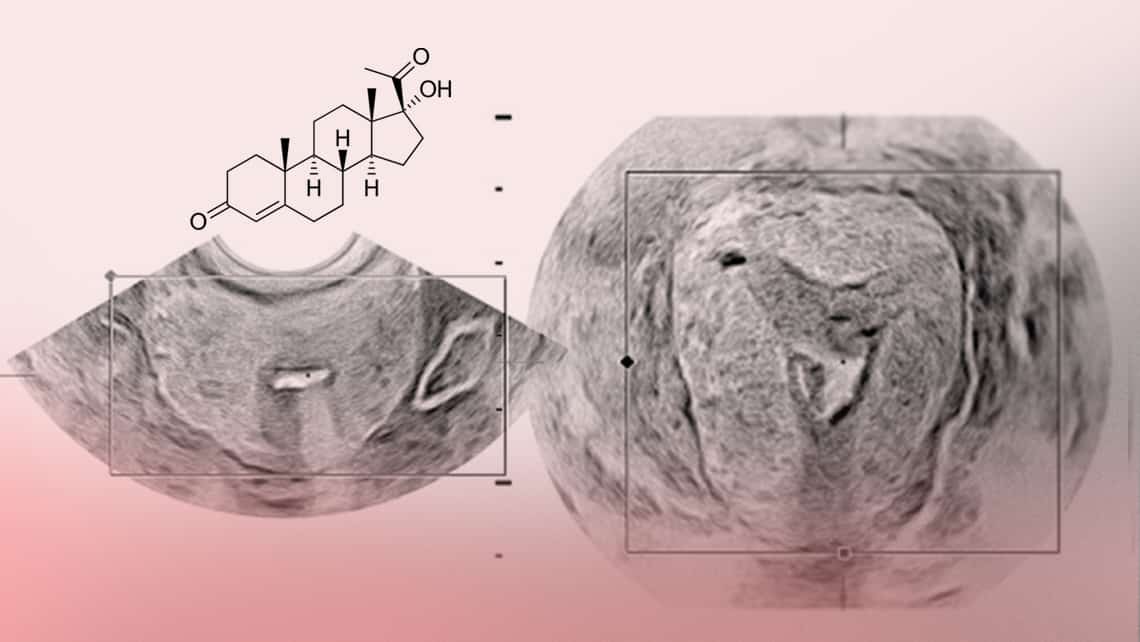
Progesterone and its role in reproduction
What is progesterone? Just a simple look at the word itself gives us an idea of what its functions are. PROGESTERONE: the hormone which facilitates pregnancy. This is a good point from which to start out.
Progesterone plays an essential role in pregnancy and it has many and varied effects. It is a natural substance which is secreted from the ovaries following ovulation and continues throughout the second half of the menstrual cycle. Progesterone ensures that a woman’s uterus is receptive and, when production is insufficient, the embryo does not implant correctly or runs a high risk of leading to a miscarriage. It also relaxes the muscles in the uterus, making it better suited for the early days of pregnancy.
In terms of a woman’s breasts, progesterone ensures that they are suitable for breastfeeding. It is also largely responsible for the symptoms which are generally associated with the early days of pregnancy. For example, constipation, drowsiness, tiredness, etc. The reason for this is that, as well as in the ovaries, it is generated in the placenta, the organ which truly sustains pregnancy.
Índice
- 1 Progesterone and assisted reproduction
- 2 Way of Administration and formulations
- 3 When and how is the progesterone test done
- 4 Progesterone levels
- 5 What is the most suitable progesterone level to achieve pregnancy?
- 6 What is the normal progesterone level during pregnancy?
- 7 High progesterone: causes and treatment
- 8 Low progesterone: causes and treatment
Progesterone and assisted reproduction
A lack of progesterone has a link to implantation failure, recurrent pregnancy loss and premature births. It is for this reason that, since it is a natural substance which poses no risks and which is highly tolerant, it is widely used in reproductive medicine.
It is used, therefore, following in vitro fertilisation (FIV) procedures as a back-up measure for embryo implantation, during the first weeks of pregnancy or for up to three or four months in patients who suffer from recurrent pregnancy loss and even throughout the entire pregnancy when there is a risk of premature birth.
Way of Administration and formulations
Progesterone can be administered in vaginal, intramuscular, subcutaneous or oral form.
Vaginal: usually in ovum form of 100, 200 y 400mg. Administration is very easy and the most frequent side effect is vaginal irritation. Most frequent commercial names are Progeffik®, Utrogestán® and Cyclogest®.
- Subcutaneous administration: it has good bioavailability and the most frequent side effect is irritation in the injection area. In Spain is commercialized as Prolutex®.
- Intramuscular: Achieves good concentrations, but it is a painful administration and requires medical assistance so is no longer in use.
- Oral administration: Its effectiveness is lower due to hepatic pass to undergo metabolism and side effects are numerous (somnolence, sickness) this is why is not the most recommended administration way for these treatments.
When and how is the progesterone test done
Progesterone determination can be done at different assisted reproduction cycles stages:
- 1. During early follicular phase (beginning od cycle), to confirm the previous cycle luteal inhibition.
- 2. In later follicular phase (near ovulation), when an optimal level will indicate a receptive endometrium.
- 3. During early and medium phase to confirm the natural production (when on natural cycles) or medication absorption (on embryo transfer cycles or with hormone replacement treatments).
Progesterone determination can be done with a peripheral blood test done at our laboratory; results can be obtained after 60 minutes.

Progesterone levels
Progesterone is secreted by the luteal body after ovulation and by the trophoblast whilst gestation. This hormone may vary depending what time of the cycle you are in, and so, its levels (under or over).
- In early follicular phase, we consider acceptable values under 0.1 to 0.7 ng/ml.
- In later follicular phase, when we want to make sure there’s no excessive early production that prevents implantation, we’ll have to obtain progesterone values under1,2-1,5 ng/ml.
- In early and medium phase, progesterone must have values over 8,8-10,5 ng/ml.
What is the most suitable progesterone level to achieve pregnancy?
A hormonal balance is important at all cycle phases to achieve pregnancy. Both exceeding levels in the first phase of the cycle and deficient levels in the second phase will prevent pregnancy. The progesterone secreted by the luteal body (or exogenously administered) will be in charge to convert proliferative endometrium into secreter endometrium, so the embryo implantation may occur.
What is the normal progesterone level during pregnancy?
Progesterone levels gradually increase during pregnancy:
- From 10 to 44 ng/ml for the first pregnancy trimester
- From 19.5 to 82.5 ng/ml for the second pregnancy trimester
- From 65 to 290 ng/ml for the third pregnancy trimester
High progesterone: causes and treatment
When undergoing ovarian stimulation on In vitro fertilization (IVF) cycles we might find a progesterone gradually increasing. Although there might be different mechanism by which progesterone increases and, it doesn’t depend on the stimulation protocols used, a high progesterone level decreases the implantation and pregnancy rates.
When we find a high progesterone level during ovarian stimulation final phase, we recommend to do the embryo transfer on a later cycle and to vitrify the embryos obtained in the current cycle.
Low progesterone: causes and treatment
We find progesterone at lower levels before transfer on either natural or hormone replacement treatments cycles. A progesterone low level at this moment complicates the embryo implantation. Treatment would be to add a progesterone supplement by either vaginal or subcutaneous administration.
IT MAY ALSO BE OF INTEREST TO YOU
- What is oestradiol? What is this sex hormone’s role?
- Fertility Treatment Medication
Dr. Rafael Bernabeu and Dra. Cristina Gavilán, ginaecologues at Instituto Bernabeu
